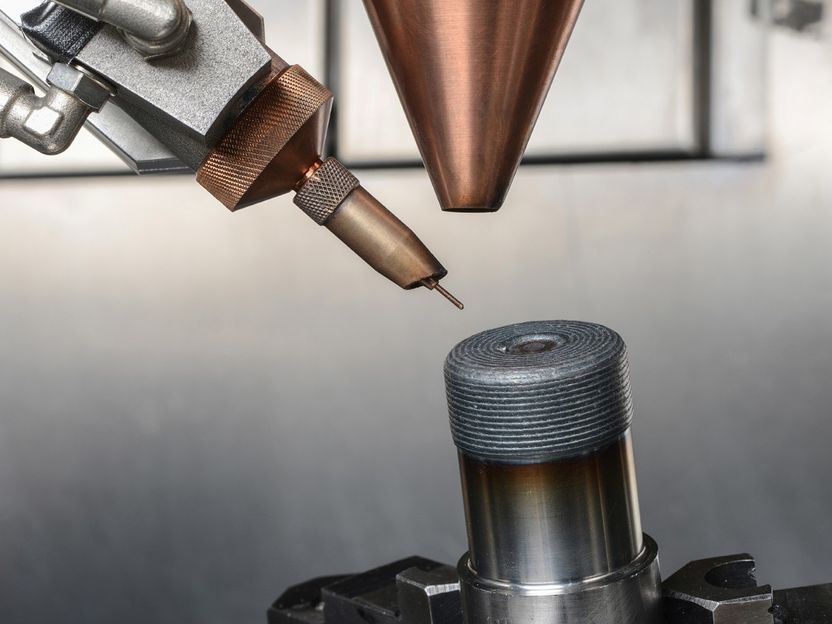Resource-efficient and cost-effective wear-resistant coatings thanks to new hybrid coating process
Hardness increases of up to 30 percent
A team of researchers at the Fraunhofer Institute for Production Technology IPT in Aachen has developed a hybrid additive manufacturing process that combines wire-based and powder-based laser cladding (LMD). The new process can be used to apply protective coatings of high-strength tool steel to workpieces and repair surface defects at low cost. The tool coatings produced in this way are more wear-resistant, resource-efficient and cost-efficient than those produced by other methods. Following successful test series with tool components, there are plans to use the process to machine hydraulic components.

The combination of wire and powder tested at the Fraunhofer IPT led to increases in the hardness of the material of up to 30 percent.
Fraunhofer IPT
Additive manufacturing processes such as laser cladding (LMD) are used to manufacture components or optimize them locally. In LMD, a laser beam is focused on the component surface; at the same time, a filler material - usually in the form of powder or wire - is fed and melted. LMD is well suited for applying protective coatings to heavily stressed components, repairing damaged areas and changing the geometry of workpieces, even for short periods.
Combination of wire and powder is flexible and cost-effective
A team of scientists from the Fraunhofer IPT, together with its international project partners, has developed a hybrid variant of laser buildup welding in the recently completed "MatLaMeD" research project, in which wire and powder are processed simultaneously. By adding hard material particles in powder form to the wire material, the team succeeded for the first time in selectively adjusting important material properties such as hardness and toughness of the applied layers. In addition, the process is significantly more cost-effective than a pure powder process and offers greater material flexibility than a pure wire process.
Individual material combinations for different requirements
To identify the best material combinations for different applications, the scientists tested numerous materials. As wire materials for the practical test series, they finally selected a hot-work tool steel with good structural stability and a low-alloy steel that can be welded well. As powder materials, they used chromium (Cr) as a carbide-forming and grain-refining element and titanium carbide (TiC) as a hard phase in the test series.
Hardness increases of up to 30 percent
By combining wire and powder, the researchers were able to flexibly adjust the material composition for each application. The addition of the powder material made it possible to selectively change the microstructure of the tool steels and increase the hardness of the applied coatings: even the addition of small amounts of titanium carbide led to hardness increases of up to 30 percent. "With the new process, we can now respond quickly and flexibly to different thermal, chemical and mechanical loads, as we can adjust toughness and hardness with pinpoint accuracy," says project manager Marius Gipperich. According to the Aachen scientist, the new process is a perfect tool for minimizing surface wear and significantly extending the service life of components.
Test series planned for machining hydraulic components
The positive results of the "MatLaMeD" project provide the researchers with a basis for further developing the new method to develop other material systems with special properties. They are also planning to use the hybrid LMD process in various application areas, such as the machining of forming tools or the treatment of friction wear layers of hydraulic components.
The researchers are currently testing the possibilities for using the hybrid LMD process in the production of graded coating systems. To do this, they want to increase the titanium carbide content of the material mixture as much as possible. Since titanium carbide can cause high residual stresses that can increase susceptibility to cracking during welding, the Aachen research team would like to adjust the TiC content individually layer by layer.
The project "MatLaMeD - Development of new processes for hybrid laser cladding" was funded as part of the "Innovations for tomorrow's production, services and work" funding initiative of the German Federal Ministry of Education and Research (BMBF).
Topics
Organizations
Other news from the department science
These products might interest you

OCA 200 by DataPhysics
Using contact angle meter to comprehensively characterise wetting behaviour, solids, and liquids
With its intuitive software and as a modular system, the OCA 200 answers to all customers’ needs

Tailor-made products for specific applications by IPC Process Center
Granulates and pellets - we develop and manufacture the perfect solution for you
Agglomeration of powders, pelletising of powders and fluids, coating with melts and polymers

Dursan by SilcoTek
Innovative coating revolutionizes LC analysis
Stainless steel components with the performance of PEEK - inert, robust and cost-effective

Get the chemical industry in your inbox
By submitting this form you agree that LUMITOS AG will send you the newsletter(s) selected above by email. Your data will not be passed on to third parties. Your data will be stored and processed in accordance with our data protection regulations. LUMITOS may contact you by email for the purpose of advertising or market and opinion surveys. You can revoke your consent at any time without giving reasons to LUMITOS AG, Ernst-Augustin-Str. 2, 12489 Berlin, Germany or by e-mail at revoke@lumitos.com with effect for the future. In addition, each email contains a link to unsubscribe from the corresponding newsletter.



























































